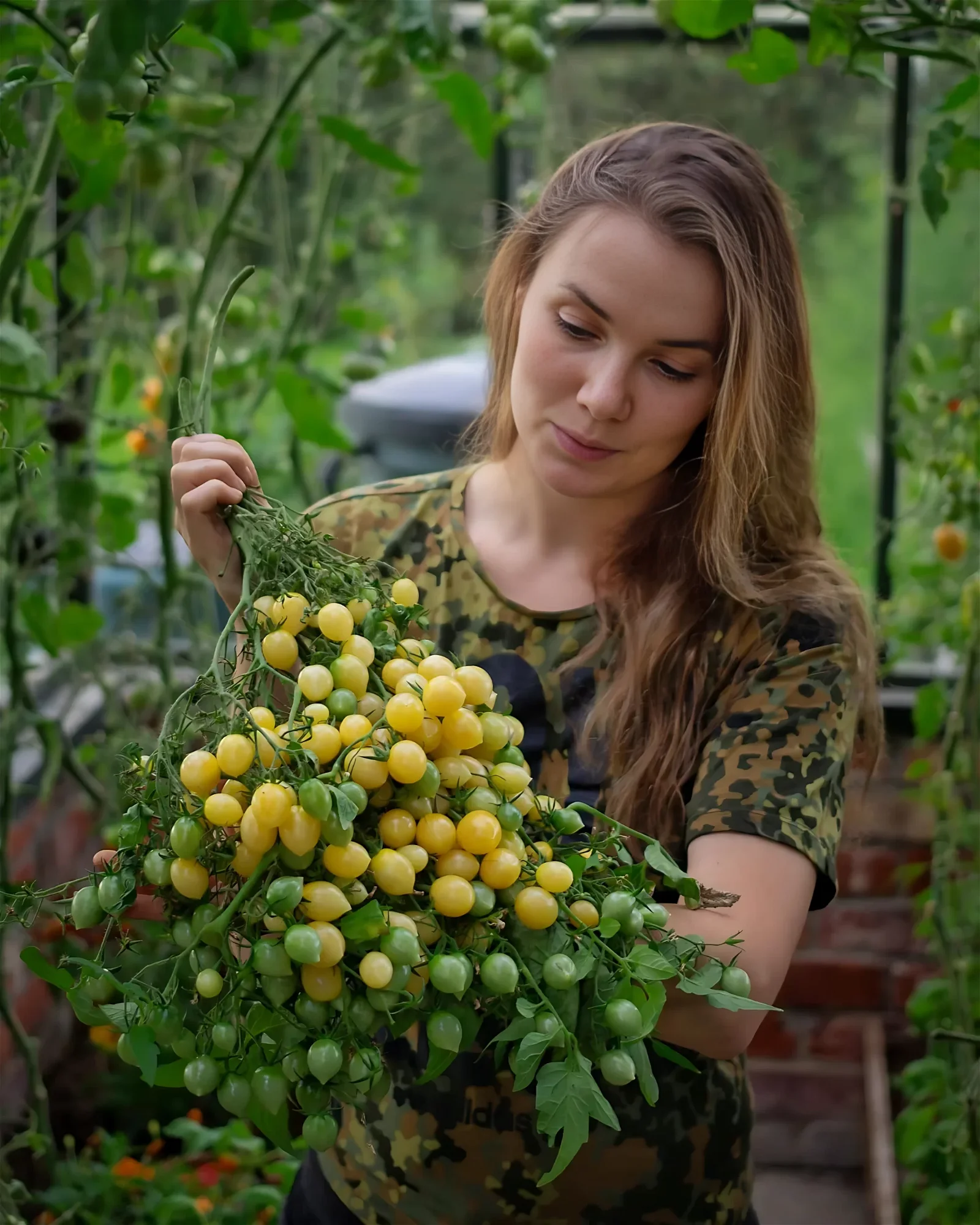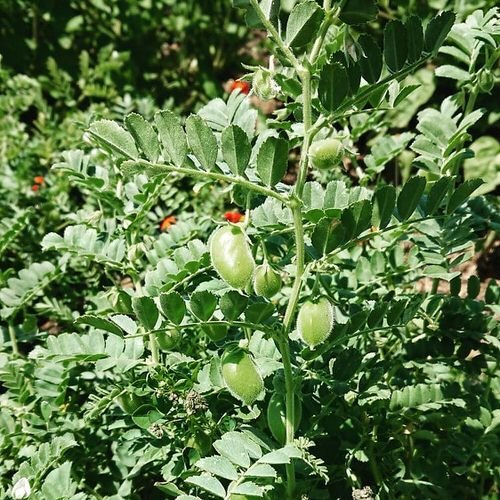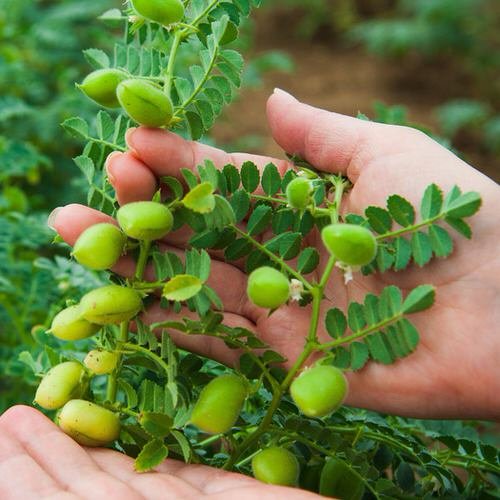Discover Planting and Growing Garbanzo Beans from seed to harvest and enjoy the rich rewards with our “How to Grow Chickpeas” guide.
Ever wonder, “Can you grow garbanzo beans?” Embark on a journey of Planting and Growing Garbanzo Beans, mastering the art of nurturing these legumes from seed to harvest. Experience the satisfaction of cultivating your own nutritious and flavorful chickpeas in the comfort of your own home. Read on to learn how to grow garbanzo beans!
USDA Zones: 2-10b
Botanical Name: Cicer arietinum
Other Names: Chickpeas, gram, chana, Kala chana, Bengali chana, Kabuli chana
Soil pH: Neutral
Pollination: Autogamous
Want to Grow Mung Beans in Pots? Click here
Garbanzo Bean Plant Information
Originating from the Mediterranean and Middle East regions, the Garbanzo bean, scientifically known as Cicer arietinum, are captivating legumes that possess a rich historical and culinary legacy.
With their distinctive appearance, these beans feature a rounded shape, showcasing a smooth, textured surface in shades ranging from beige to light brown. When cooked to perfection, garbanzo beans reveal a delightful creaminess and a flavor profile that exudes a harmonious blend of nuttiness and earthiness.
Their unique attribute lies in their remarkable ability to readily absorb the flavors of spices, herbs, and seasonings, rendering them a sought-after ingredient in a wide array of cuisines worldwide. Whether incorporated into savory stews, transformed into creamy hummus, or tossed into vibrant salads, garbanzo beans truly shine as a versatile and delightful addition to culinary creations.
Learn about the Best Bean Varieties here
How to Grow Garbanzo Beans?
Wondering how do garbanzo beans grow? For growing garbanzo beans, select large and dry seeds that are free from mold and damage. Purchase seeds only from a quality source. Here is how you can grow garbanzo beans from seeds.
- Select the right garbanzo bean variety suitable for your climate and growing conditions.
- Prepare the soil by removing weeds and incorporating organic matter like compost.
- Sow garbanzo bean seeds directly into the soil after the danger of frost has passed.
- Dig small holes about 1-2 inches deep, spacing them 4-6 inches apart and drop a seed into each hole and cover it with soil, gently patting it down.
- Water regularly, aiming for about 1 inch of water per week.
- Ensure the plants receive 6-8 hours of direct sunlight daily.
- Apply organic mulch around the plants to conserve moisture and suppress weed growth.
- Harvest when the pods have turned brown and are dry to the touch.
- Allow harvested pods to dry further indoors before removing the beans from the pods.
Learn about Growing Pinto Beans here
Pot Size for Growing Garbanzo Beans
Want to learn how to grow garbanzo beans indoors? Best know what pot size to choose. When growing garbanzo beans, it is generally recommended to use pots or containers that are at least 12 inches (30 cm) in diameter and 12 inches (30 cm) deep. This size provides enough space for the roots to develop and allows for proper growth and production of the plant.
However, if you have larger pots available, such as 18 inches (45 cm) or more in diameter, it can provide even better conditions for the plants. The key is to ensure sufficient room for the roots to spread and access necessary nutrients and water.
Here are Plant Pot Sizes from Inches to Gallon
Requirements for Growing Garbanzo Beans
Location
Want to learn how to grow garbanzo beans at home? Choose a sunny spot for growing garbanzo beans. They love sunlight and thrive in locations that receive at least 6-8 hours of direct sunlight each day.
Find an area in your garden or yard that provides ample sunlight for these legumes to grow and flourish.
Soil
Wondering where do garbanzo beans grow? Garbanzo beans prefer well-drained soil that is rich in organic matter. Loamy soil works best for them. Before planting, make sure to remove any weeds or debris from the soil.
Find out some Helpful Hacks to Improve Your Garden Soil for Free here
You can also improve the soil quality by adding compost or well-rotted manure, which will provide essential nutrients for the plants to grow.
Water
Garbanzo beans require regular watering to keep the soil consistently moist. Water them deeply once or twice a week, aiming for about 1 inch of water per week. However, avoid overwatering as it may lead to waterlogged conditions and root rot.
Learn How to Treat Root Rot in Houseplants Like a Pro here
The key is to maintain a balance by keeping the soil moist but not overly saturated.
Temperature
Garbanzo beans thrive in warm temperatures. Want to know the garbanzo bean growing zone? They prefer a temperature range of about 70-80°F (21-27°C) during the growing season and thrive in USDA zones 2-10b.
Make sure to plant them after the danger of frost has passed, as they are not frost-tolerant. If you live in a cooler climate, it’s best to wait until the soil has warmed up before planting.
Humidity
Garbanzo beans can tolerate a range of humidity levels, but they generally prefer moderate humidity. They can adapt to both dry and humid conditions. However, good air circulation is important to prevent the development of fungal diseases.
Ensure that there is adequate spacing between plants, and consider using stakes or trellises to improve airflow around the plants.
Here are 10 Ways To Increase Humidity For Houseplants That Work
Garbanzo Beans Care
Fertilizer
Garbanzo beans, like other legumes, are used for nitrogen fixation, which means that nitrogen, which is in the air, gets back into the soil. The addition of nitrogen fertilizer is not necessary.
Here is a DIY Potassium Rich Plant Fertilizer
However, if your soil lacks fertility, you can provide a balanced organic fertilizer during planting or in small doses throughout the growing season. Avoid excessive nitrogen fertilizers, as they can lead to excessive foliage growth at the expense of pod development.
Pruning
Garbanzo beans typically do not require extensive pruning. However, you can remove any dead or yellowing leaves, as well as any damaged or diseased parts of the plant. This helps improve airflow and reduces the risk of diseases.
Pests and Diseases
Growing garbanzo beans requires care against pests and diseases. Cutworms, aphids, chickpea leafminers, pod borers, grasshoppers, and beet armyworms are the insects that attack them.
The application of organic pesticides and neem oil is recommended to deter them. Ascochyta blight, root rot, and stem rot are common diseases, these diseases can be prevented by avoiding overhead and overwatering.
Want to Grow Castor Beans? Click here
Harvesting Garbanzo Beans
Chickpeas will be ready to harvest between 90-110 days after planting. You can pick garbanzo beans when the pods swell. The beans taste best when they are fresh.
For dried chickpeas, allow the plant to turn brown before collecting the pods.







I’m having a hard time finding seed for sale? Do you have any sources?
Walmart.com garbanzo seed – organic, 9.95 for 1 lb. Ship to you or pick up at you local store. Hope that helps :-)
Another idiot. 0.99 cents per pound at any grocery store
Grand Prismatic Seeds
Uprising Seeds, Bellingham, Wa. is an excellent source for Black Kabuli garbanzo seeds {& many other high quality veg & flower seeds}.
I love your blog, but adding sand to clay only creates concrete-like soil. Adding organic material, such as aged compost, or mulching with free arborist wood chips are much more effective at improving soil structure.
I just thought of planting them kind of late in the season, but I’m thinking that I will plant them anyway just to nourish the soil. If I get any beans, great! But if not, it isn’t wasted.